Martin Kippenberger New York zum Russisch Abbinden (NYZRA) 1985 Oil and silicone on canvas in four panels. 60 1/4 x 72 in. (153 x 183 cm) overall.
Provenance Galerie Bärbel Grässlin, Frankfurt; Private collection, Europe Catalogue Essay Martin Kippenberger But somehow one is sincere. One really wants to tell just heart and blood, and about the gastric acid. One just tries to do justice to everything. One wants to reach the people. In fact, one is a small priest, isn’t one? So, somehow, parson—parson? Pastor—I’m a pastor. And pastor means translated… Jutta Koether Shepherd. Martin Kippenberger Shepherd. Yeah. And somehow I have something like it, haven’t I? I’m the holy Saint Martin. There is the half-half-half, isn’t it? Everybody should have it nice and warm in his corner. Yeah. In the calm corner [blows into the microphone]. We’re all searching for it, and if you know where it is, then you may rent it—at first [laughs]. That’s exciting. That’s dynamic. And that’s what I’ve already been when I was a kid, no matter whether it was with alcoholism or with drugs or something else. I’ve always been soooo…fast; always watched the sky too. Looked out the window at school, so I wasn’t quite concentrated—though, of course, very concentrated in other matters—watching! (J. Koether, ed. “One has to be able to take it! Excerpts from an interview with Martin Kippenberger by Jutta Koether November 1990 – May 1991,” Martin Kippenberger The Problem Perspective, Cambridge, 2008, p. 320) In his short life, Martin Kippenberger created a unique, provocative body of work centered on the role of the artist in culture that has established him as one of the most significant and influential artists of his generation. In his diverse practice, the artist could be inspired by anything he encountered to create a work of art as a painting, work on paper, sculpture, invitation or poster.Taking on the accepted high art of painting, Kippenberger found the perfect self-reflective platform to question everything about what it means to be an artist and the creative act of making art itself.With his famously larger-than-life personality, he took on the role of provocateur. "The boundaries between art and life, public and private, were not so much traversed in Kippenberger’s enterprise as they were destabilized through his embrace of their contradictions. That instability is fundamental to his challenge to the spectator. To encounter a work by Kippenberger is to experience the discomfort and embarrassment of getting too close, of knowingmore than one would wish to know or admit, of confronting something that is banal and annoying, that dismisses received notions of right or wrong. His work is not simply about getting to the truth or unearthing dirty secrets, but about uncovering the mechanisms that produce meaning and the ways in which they define the role and position of the artist," (A. Goldstein, “The Problem Perspective,” Martin Kippenberger The Problem Perspective, Cambridge, 2008, p. 40). In his paintings of the mid-1980s, Kippenberger continued to explore identity on a personal, regional and national level, dealing with subjects such as Socialism, Communism and even Nazi history. In the present lot, New York zum Russisch Abbinden (NYZRA), 1985, the artist takes on the subject of the Cold War which had reached a critical moment in this time period. The painting contains the romantic image of the NewYork skyline split between four canvases joined together. The gaps between the canvas suggest that there is something disjointed, fragile, or perhaps even corrupt within this symbol of Western capitalism and power. In his typically antagonistic fashion, Kippenberger talks about the United States: "Well, the one and only core of Americans’ identity was film and music, respectively—which, meanwhile, have been lost, been sold to Japan. The USA once again lost everything because they’ve always done everything wrong. First they got themselves the Bubus, then, destroyed the red Indians, lost a war here and there, fought against each other, lost again, hostage liberation: crashed into each other’s helicopters
Martin Kippenberger New York zum Russisch Abbinden (NYZRA) 1985 Oil and silicone on canvas in four panels. 60 1/4 x 72 in. (153 x 183 cm) overall.
Provenance Galerie Bärbel Grässlin, Frankfurt; Private collection, Europe Catalogue Essay Martin Kippenberger But somehow one is sincere. One really wants to tell just heart and blood, and about the gastric acid. One just tries to do justice to everything. One wants to reach the people. In fact, one is a small priest, isn’t one? So, somehow, parson—parson? Pastor—I’m a pastor. And pastor means translated… Jutta Koether Shepherd. Martin Kippenberger Shepherd. Yeah. And somehow I have something like it, haven’t I? I’m the holy Saint Martin. There is the half-half-half, isn’t it? Everybody should have it nice and warm in his corner. Yeah. In the calm corner [blows into the microphone]. We’re all searching for it, and if you know where it is, then you may rent it—at first [laughs]. That’s exciting. That’s dynamic. And that’s what I’ve already been when I was a kid, no matter whether it was with alcoholism or with drugs or something else. I’ve always been soooo…fast; always watched the sky too. Looked out the window at school, so I wasn’t quite concentrated—though, of course, very concentrated in other matters—watching! (J. Koether, ed. “One has to be able to take it! Excerpts from an interview with Martin Kippenberger by Jutta Koether November 1990 – May 1991,” Martin Kippenberger The Problem Perspective, Cambridge, 2008, p. 320) In his short life, Martin Kippenberger created a unique, provocative body of work centered on the role of the artist in culture that has established him as one of the most significant and influential artists of his generation. In his diverse practice, the artist could be inspired by anything he encountered to create a work of art as a painting, work on paper, sculpture, invitation or poster.Taking on the accepted high art of painting, Kippenberger found the perfect self-reflective platform to question everything about what it means to be an artist and the creative act of making art itself.With his famously larger-than-life personality, he took on the role of provocateur. "The boundaries between art and life, public and private, were not so much traversed in Kippenberger’s enterprise as they were destabilized through his embrace of their contradictions. That instability is fundamental to his challenge to the spectator. To encounter a work by Kippenberger is to experience the discomfort and embarrassment of getting too close, of knowingmore than one would wish to know or admit, of confronting something that is banal and annoying, that dismisses received notions of right or wrong. His work is not simply about getting to the truth or unearthing dirty secrets, but about uncovering the mechanisms that produce meaning and the ways in which they define the role and position of the artist," (A. Goldstein, “The Problem Perspective,” Martin Kippenberger The Problem Perspective, Cambridge, 2008, p. 40). In his paintings of the mid-1980s, Kippenberger continued to explore identity on a personal, regional and national level, dealing with subjects such as Socialism, Communism and even Nazi history. In the present lot, New York zum Russisch Abbinden (NYZRA), 1985, the artist takes on the subject of the Cold War which had reached a critical moment in this time period. The painting contains the romantic image of the NewYork skyline split between four canvases joined together. The gaps between the canvas suggest that there is something disjointed, fragile, or perhaps even corrupt within this symbol of Western capitalism and power. In his typically antagonistic fashion, Kippenberger talks about the United States: "Well, the one and only core of Americans’ identity was film and music, respectively—which, meanwhile, have been lost, been sold to Japan. The USA once again lost everything because they’ve always done everything wrong. First they got themselves the Bubus, then, destroyed the red Indians, lost a war here and there, fought against each other, lost again, hostage liberation: crashed into each other’s helicopters
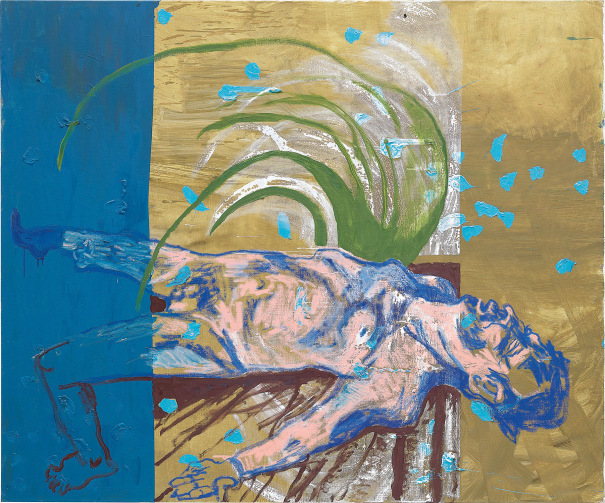
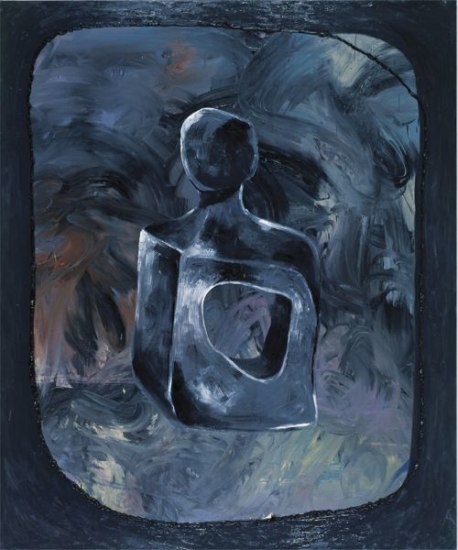
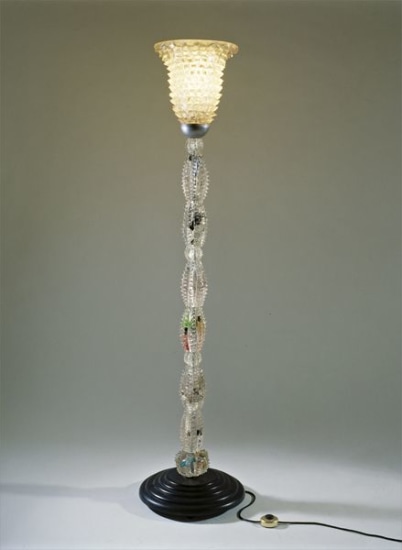

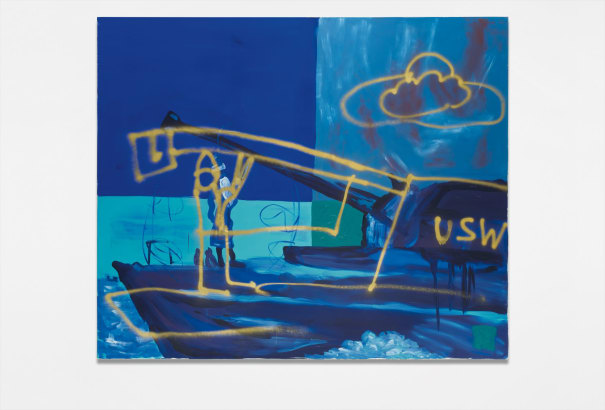


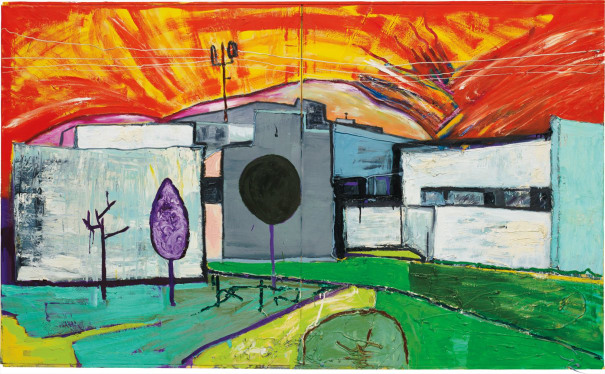
.jpg)



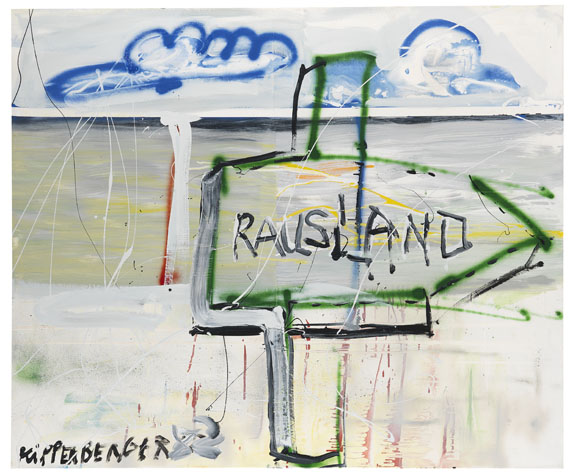
Testen Sie LotSearch und seine Premium-Features 7 Tage - ohne Kosten!
Lassen Sie sich automatisch über neue Objekte in kommenden Auktionen benachrichtigen.
Suchauftrag anlegen